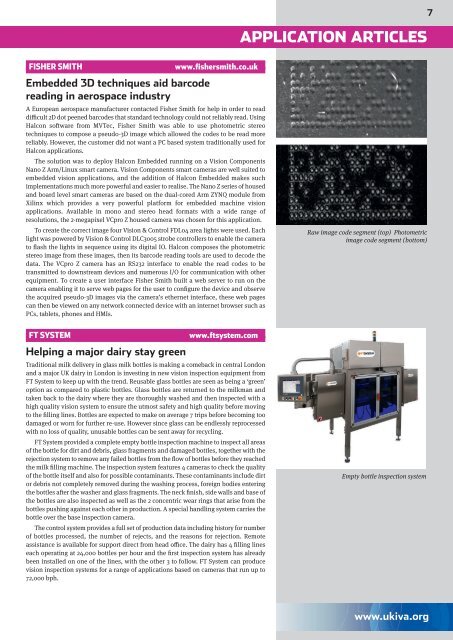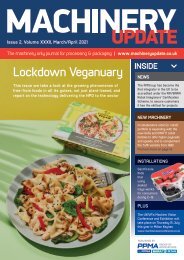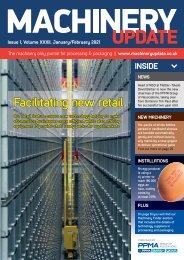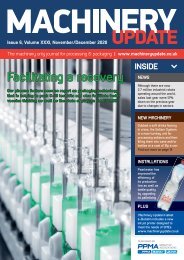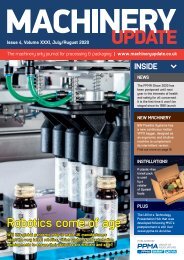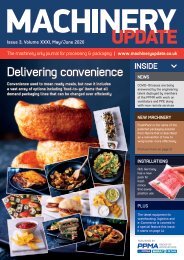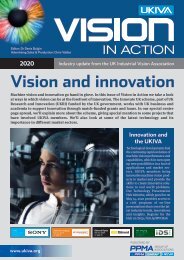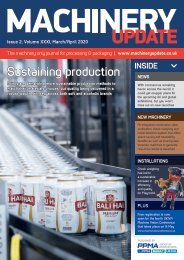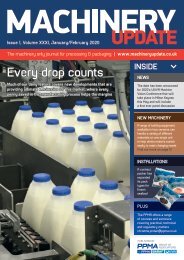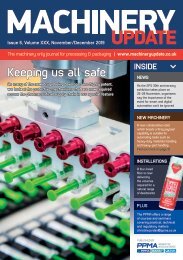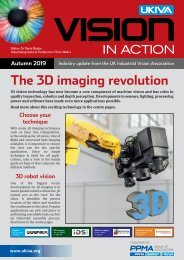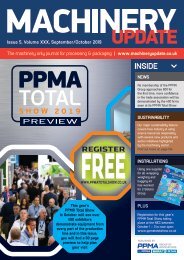VIA Autumn 2018 On-Line
You also want an ePaper? Increase the reach of your titles
YUMPU automatically turns print PDFs into web optimized ePapers that Google loves.
APPLICATION ARTICLES<br />
7<br />
FISHER SMITH<br />
Embedded 3D techniques aid barcode<br />
reading in aerospace industry<br />
www.fishersmith.co.uk<br />
A European aerospace manufacturer contacted Fisher Smith for help in order to read<br />
difficult 2D dot peened barcodes that standard technology could not reliably read. Using<br />
Halcon software from MVTec, Fisher Smith was able to use photometric stereo<br />
techniques to compose a pseudo-3D image which allowed the codes to be read more<br />
reliably. However, the customer did not want a PC based system traditionally used for<br />
Halcon applications.<br />
The solution was to deploy Halcon Embedded running on a Vision Components<br />
Nano Z Arm/Linux smart camera. Vision Components smart cameras are well suited to<br />
embedded vision applications, and the addition of Halcon Embedded makes such<br />
implementations much more powerful and easier to realise. The Nano Z series of housed<br />
and board level smart cameras are based on the dual-cored Arm ZYNQ module from<br />
Xilinx which provides a very powerful platform for embedded machine vision<br />
applications. Available in mono and stereo head formats with a wide range of<br />
resolutions, the 2-megapixel VCpro Z housed camera was chosen for this application.<br />
To create the correct image four Vision & Control FDL04 area lights were used. Each<br />
light was powered by Vision & Control DLC3005 strobe controllers to enable the camera<br />
to flash the lights in sequence using its digital IO. Halcon composes the photometric<br />
stereo image from these images, then its barcode reading tools are used to decode the<br />
data. The VCpro Z camera has an RS232 interface to enable the read codes to be<br />
transmitted to downstream devices and numerous I/O for communication with other<br />
equipment. To create a user interface Fisher Smith built a web server to run on the<br />
camera enabling it to serve web pages for the user to configure the device and observe<br />
the acquired pseudo-3D images via the camera’s ethernet interface, these web pages<br />
can then be viewed on any network connected device with an internet browser such as<br />
PCs, tablets, phones and HMIs.<br />
FT SYSTEM<br />
Helping a major dairy stay green<br />
www.ftsystem.com<br />
Traditional milk delivery in glass milk bottles is making a comeback in central London<br />
and a major UK dairy in London is investing in new vision inspection equipment from<br />
FT System to keep up with the trend. Reusable glass bottles are seen as being a ‘green’<br />
option as compared to plastic bottles. Glass bottles are returned to the milkman and<br />
taken back to the dairy where they are thoroughly washed and then inspected with a<br />
high quality vision system to ensure the utmost safety and high quality before moving<br />
to the filling lines. Bottles are expected to make on average 7 trips before becoming too<br />
damaged or worn for further re-use. However since glass can be endlessly reprocessed<br />
with no loss of quality, unusable bottles can be sent away for recycling.<br />
FT System provided a complete empty bottle inspection machine to inspect all areas<br />
of the bottle for dirt and debris, glass fragments and damaged bottles, together with the<br />
rejection system to remove any failed bottles from the flow of bottles before they reached<br />
the milk filling machine. The inspection system features 4 cameras to check the quality<br />
of the bottle itself and also for possible contaminants. These contaminants include dirt<br />
or debris not completely removed during the washing process, foreign bodies entering<br />
the bottles after the washer and glass fragments. The neck finish, side walls and base of<br />
the bottles are also inspected as well as the 2 concentric wear rings that arise from the<br />
bottles pushing against each other in production. A special handling system carries the<br />
bottle over the base inspection camera.<br />
The control system provides a full set of production data including history for number<br />
of bottles processed, the number of rejects, and the reasons for rejection. Remote<br />
assistance is available for support direct from head office. The dairy has 4 filling lines<br />
each operating at 24,000 bottles per hour and the first inspection system has already<br />
been installed on one of the lines, with the other 3 to follow. FT System can produce<br />
vision inspection systems for a range of applications based on cameras that run up to<br />
72,000 bph.<br />
Raw image code segment (top) Photometric<br />
image code segment (bottom)<br />
Empty bottle inspection system<br />
www.ukiva.org


